
Arulmigu Murugan Temple, Thiruparankundram is a Hindu temple dedicated to the god Murugan at Thiruparankundram, Tamilnadu, India. It is regarded as one of the "First Houses of Murugan". The temple uses rock-cut architecture and is believed to have been built by the Pandyas during the 6th century. According to legend, Murugan slayed the demon Surapadman and married his consort Devasena at the temple. Murugan is also said to have worshipped his father Shiva at the site as Parangirinathar.

Thiruvathigai Veerateswarar Temple is a Hindu temple dedicated to Shiva. It is situated in Thiruvathigai village which is about 2 kilometres east from the town of Panruti in the South Indian state of Tamil Nadu, India. Shiva is worshiped as Veerattaaneswarar, and is represented by the lingam. His consort Parvati is depicted as Thiripurasundari. The presiding deity is revered in the 7th-century-CE Tamil Saiva canonical work, the Tevaram, written by Tamil saint poets known as the nayanars and classified as Paadal Petra Sthalam. The temple is considered the place where the Saiva saint poet Appar (Thirunavukkarasar) converted back to Saivism, and attained final salvation.
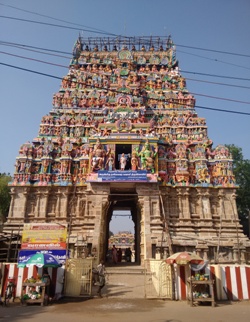
Nageswaraswamy Temple is a Hindu temple dedicated to Shiva located in Kumbakonam in Thanjavur district, Tamil Nadu, India. The presiding deity is revered in the 7th-century Tamil Saiva canonical work, the Tevaram, written by Tamil poet saints known as the nayanars and classified as Paadal Petra Sthalam. The temple is counted as the earliest of all Chola temples. Shiva in the guise of Nagaraja, the serpent king..

Tirunageswaram Naganathar Temple also known as Rahu Stalam is a Hindu temple dedicated to the deity Shiva, located in Tirunageswaram, a village in the outskirts of Kumbakonam, a town in Tamil Nadu, India. It is significant to the Hindu sect of Saivism as one of the temples associated with the nine planet elements, the Navagraha Stalas, and specifically Rahu. Shiva is worshiped as Naganathar, and is represented by the lingam. His consort Parvati is depicted as Piraisoodi Amman. The presiding deity is revered in the 7th-century Tamil Saiva canonical work, the Tevaram, written by Tamil saint poets known as the nayanars and classified as Paadal Petra Sthalam.
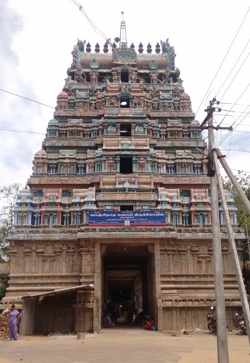
Vanchinadha Swamy temple is a Hindu temple dedicated to the deity Shiva, located in Srivanchiyam, Tiruvarur District, Tamil Nadu, India. Shiva is worshiped as Vanchinadha Swamy, and is represented by the lingam. His consort Parvati is depicted as Mangalambigai Amman. The presiding deity is revered in the 7th century Tamil Saiva canonical work, the Tevaram, written by Tamil saint poets known as the Nayanmars and classified as Paadal Petra Sthalam.

Sakshinatheswarar Temple or Thiruppurambiyam Temple is a Hindu temple dedicated to the God Shiva located in Thiruppurambiyam, Tamil Nadu, India. Shiva is worshipped as Sakshinathar, and is represented here by a Lingam. His consort, Parvati, is depicted as Ikshuvani. The presiding deity is revered in the 7th century Tamil Saiva canonical work, Thevaram, written by Tamil saint poets, known as the Nayanmaars and classified as Paadal Petra Sthalam.

Pushpavananathar Temple is a Hindu temple dedicated to Shiva located in the village of Tiruppoonturutti near Tiruvaiyaru, Tamil Nadu, India. Shiva is worshiped as Aiyarappar, and is represented by the lingam and his consort Parvati is depicted as Soundaranayagi. The presiding deity is revered in the 7th century Tamil Saiva canonical work, the Tevaram, written by Tamil poet saints known as the nayanars and classified as Paadal Petra Sthalam.

ThirumarperuManikandeswarar Temple is a Hindu temple dedicated to Shiva in Tirumalpur in Ocheri-Tirumalpur road, Tamil Nadu, India. Constructed in the Dravidian style of architecture, the temple is believed to have been built during the Cholas period in the 9th century. Shiva is worshipped as Manikandeswarar and his consort Parvathi as Karunai Nayagi.

Pasupatheeswarar Temple, Avoor or Avoor Pasupatheeswaram is a Hindu temple dedicated to Hindu god Shiva, located in the village Avoor, located 12 km south of South Indian town, Kumbakonam, Tamil Nadu, India. The temple is one of the 3 madakoil built by 7th century Chola king, Kochengat Chola. The temple is known for the Panjakavyamuthra, the five images of Bhairava vijay. The temple is revered in the verses of Tevaram, the 17th century Tamil Saiva canon by Tirugnana Sambandar.

Uma Maheswarar Temple of Konerirajapuram in the Mayiladuthurai district in the South Indian state of Tamil Nadu, is a historical temple dedicated to Shiva. Shiva is worshiped as Uma Maheswarar, and is represented by the lingam and his consort Parvati is depicted as Mattuvar Kuzhalammai. The presiding deity is revered in the 7th century Tamil Saiva canonical work, the Tevaram, written by Tamil saint poets known as the nayanars and classified as Paadal Petra Sthalam.
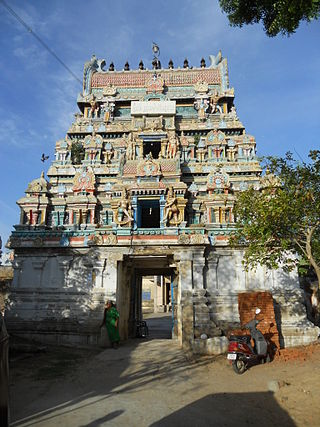
Padikasu Nathar Temple is a Hindu temple located at Azhagaputhur, a village in the Thanjavur district of Tamil Nadu, India. Shiva is worshiped as Padikasunathar, and is represented by the lingam. His consort Parvati is depicted as Soundaranayagi. The presiding deity is revered in the 7th century Tamil Saiva canonical work, the Tevaram, written by Tamil saint poets known as the nayanars and classified as Paadal Petra Sthalam. The 8th century Saiva saint poet Sundarar has sung praise about the temple in his works.

Sivapuri Uchinathar Temple is a Hindu temple located at Sivapuri in Cuddalore district of Tamil Nadu, India. The place is also known as Thirunelvayil. The presiding deity is Shiva. He is called as Uchinathar. His consort is known as Uchinayagi.

Tirukkazhippalai Palvannanathar Temple is a Hindu temple located at Sivapuri in Cuddalore district of Tamil Nadu, India. The presiding deity is Shiva in the form of Palvannanathar and his consort is known as Vedanayaki. The presiding deity is revered in the 7th century Tamil Saiva canonical work, the Tevaram, written by Tamil saint poets known as the nayanmars and classified as Paadal Petra Sthalam.
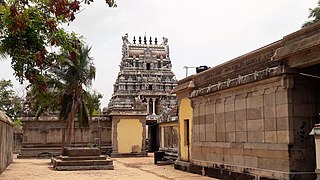
Agastheeswarar Temple is a Hindu temple dedicated to Shiva, located in the town of Agasthiyampalli, Nagapattinam district in Tamil Nadu, India. The presiding deity is revered in the seventh century Tamil Saiva canonical work, the Tevaram, written by Tamil saint poets known as the nayanmars and classified as Paadal Petra Sthalam. The temple is locally called Agasthiyar Kovil.

Chandramowleeswarar Temple, Thiruvakkarai in Thiruvakkarai, a village in Villupuram district in the South Indian state of Tamil Nadu, is dedicated to the Hindu god Shiva. Constructed in the Tamilian style of architecture, the temple is believed to have been built during the Cholas period in the 10th century. The temple has received gracious endowments from the Chola queen Sembiyan Mahadevi. Shiva is worshipped as Chandramowleeswarar and his consort Parvathi as Amirthambigai.

Kripapureeswarar Temple in Thiruvennainallur, a panchayat town in Villupuram district in the South Indian state of Tamil Nadu, is dedicated to the Hindu god Shiva. The presiding deity is revered in the 7th century Tamil Saiva canonical work, the Tevaram, written by Tamil saint poets known as the Nayanmars and classified as Paadal Petra Sthalam. The temple is closely associated with Sundarar, the saivite saint of the 8th century, who started composing his Tirumurai starting with "Pitha Piraisudi" verse in this temple.

Thirumuruganatheeswarar Temple in Thirumuruganpoondi, a panchayat town in Tiruppur district in the South Indian state of Tamil Nadu, is dedicated to the Hindu god Shiva. Constructed in the Dravidian style of architecture, the present structure of the temple is believed to have been built during the Kongu Cholas period in the 10th century. Shiva is worshipped as Thirumuruganatheeswarar and his consort Parvathi as Avudainayagi.

Marudeeswarar Temple is a Hindu temple dedicated to the deity Shiva, located in T. Edaiyar, a village in Viluppuram district in the South Indian state of Tamil Nadu. Shiva is worshipped as Marudeeswarar, and is represented by the lingam. His consort Parvati is depicted as Gnanambigai. The temple is located on the Southern banks of Thenpennai River on the Thirukoilur - Thiruvennainallur road. The presiding deity is revered in the 7th century Tamil Saiva canonical work, the Tevaram, written by Tamil saint poets known as the nayanmars and classified as Paadal Petra Sthalam.
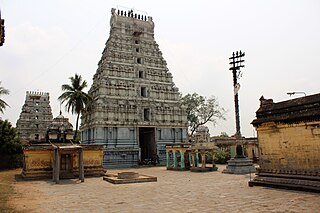
Abirameswarar Temple is a Hindu temple dedicated to the deity Shiva, located in thiruvamaathur, a village in Viluppuram district in the South Indian state of Tamil Nadu. Shiva is worshiped as Abirameswarar, and is represented by the lingam. His consort Parvati is depicted as Manonmani Amman. The temple is located on the Chennai - Villupuram highway. The presiding deity is revered in the 7th century Tamil Saiva canonical work, the Tevaram, written by Tamil saint poets known as the nayanmars and classified as Paadal Petra Sthalam.

Pushpavaneswarar temple in Thirupuvanam, a town in Sivaganga district in the South Indian state of Tamil Nadu, is dedicated to the Hindu god Shiva. Constructed in the Dravidian style of architecture, the temple is believed to have been built during the Cholas period in the 7th century. Shiva is worshipped as Pushpavaneswarar and his consort Parvathi as Soundaranayagi.


























